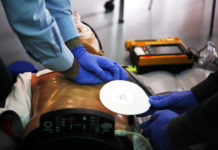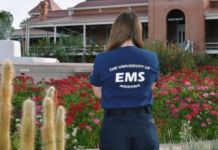| Download PDF (Available Soon) | |
| Author and Article Information |
Abstract
Although college campuses have historically been regarded as a protective influence against the development of substance use disorders, substance use and misuse have risen to become one of the most widespread public health concerns facing U.S. college campuses in the past decade. The co-ingestion of alcohol and opioids involves complex pharmacological interactions, resulting in various symptoms and physiological manifestations in patients. The inherent ambiguity surrounding patient presentations with polysubstance misuse underscores the need for a comprehensive assessment with a systematic approach. This article discusses pertinent pharmacology, clinical presentations, and treatment guidelines for co-ingestion of alcohol and opioids.
Introduction
Excessive college drinking is a significant public health issue, with the potential to inflict significant morbidity. The 2019 National Survey on Drug Use and Health (NSDUH) reported that over half (52.5%) of full-time college students drank alcohol over the past month, and a third (33%) engaged in binge drinking over the past month. Moreover, young adults between the ages of 14 to 18 years old who are enrolled in college are likely to drink in excess compared to their non-college peers.1 Accordingly, collegiate-based EMS providers may respond to a higher frequency of alcohol-related calls than other EMS providers.2
Drug overdose is the leading cause of accidental deaths in the US, having increased by 30% from 2019 to 2020, with 75% involving opioids such as heroin, morphine, and fentanyl.3 In that time, prescription opioid-involved deaths increased by 17%, and synthetic opioid-involved deaths increased by 56% compared to the previous year. This crisis affects both young and old. In 2017, it was reported that 1 in 4 young adults aged 18 to 25 used illicit drugs, including prescription opioid abuse and opioid use. Moreover, drug abuse is projected to increase among college-age individuals in the upcoming years.4
College campuses embody a social culture that exposes young adults to opportunities for drug and alcohol use. These substances are more lethal when combined due to their synergistic effects on respiratory depression.5 Therefore, alcohol and opioid co-ingestion presents a unique, unprecedented challenge to collegiate-based EMTs.6 In anticipation of simultaneous use, collegiate-based EMTs should be aware and knowledgeable of pharmacology, clinical manifestations, and treatment procedures for alcohol and opioid co-ingestion.
Pharmacology
Alcohol pharmacology
Alcohol (ethanol) is a central nervous system depressant that acts directly on multiple neurotransmitter systems, leading to altered levels of consciousness and impaired communication between the brain and spinal cord.7 The most clinically important mechanism of alcohol intoxication is sedative-hypnotic effects via agonism of GABAA (gamma-aminobutyric acid), the primary inhibitory receptor in the central nervous system. Ethanol binds to the GABAA receptor, leading to an influx of chloride ions that causes neuron hyperpolarization. Hyperpolarization decreases the likelihood of a neuron reaching its action potential threshold, resulting in reduced firing and nervous system inhibition.8 Ethanol also stimulates glycine receptors, which are also inhibitory, and antagonizes the excitatory NMDA glutamate receptor. Combining these pharmacologic mechanisms produces an array of well-known effects including dissociation, motor impairment, and social disinhibition.
Clinical manifestations and physiological symptoms of alcohol intoxication
Alcohol consumption results in sedative and anxiolytic effects, which manifest with symptoms of relaxation and drowsiness. It also causes changes in behavioral, physical, and cognitive functions. Examples of functional change include slower reaction time, motor incoordination, and impaired judgment. Lower doses of alcohol produce impaired judgment and motor coordination and can also be associated with increased aggression in some users. At high enough doses, the sedative effect ultimately predominates, leading to decreased level of consciousness and, eventually, coma. A standard single drink contains 14 g of ethanol, which is assumed to increase the blood alcohol concentration (BAC) of a 70-kg man by 15–20 mg/dL, or 0.015% – 0.020%. In general, a high dose of alcohol that may induce sedation is typically considered to be above the legal blood alcohol concentration (BAC) limit for driving, around 0.08%. A lower dose of alcohol producing minimal sedative effects or disinhibition would occur at a BAC of approximately 0.020%, which may correspond to between one to three standard drinks depending on the person.9 However, due to variances in gender, genetics, metabolism, size, and tolerance from habitual use, the dosing threshold for these effects can vary widely from one individual to another.
Typical clinical manifestations of alcohol overdose include confusion, vomiting, slow or irregular breathing, pale skin, and lower body temperature. High doses may cause respiratory depression (slowed breathing rate and potentially respiratory failure) with loss of consciousness. Other physiological symptoms include cardiovascular effects and vasodilation, resulting in a drop in blood pressure, tachycardia, dehydration (caused by alcohol’s diuretic effects thus decreasing circulating plasma volume), and hypoglycemia which may cause altered mentation, seizures, and other potentially serious complications.10
Opioid pharmacology
Opioid drugs stimulate multiple families of opioid receptors in the brain, spinal cord, and other organs. These receptors regulate sleep, digestion, and pain perception. Drug-induced stimulation of mu-opioid receptors during recreational use results in altered perceptions of pain and heightened feelings of pleasure and euphoria.11
Opioids may be opiates (e.g., natural derivatives of the poppy plant) such as morphine or codeine, semi-synthetic compounds chemically modified from opiates such as oxycodone, or fully synthetic compounds that stimulate opioid receptors such as fentanyl or methadone. Fentanyl is 50-100 times more potent than morphine, and modified forms such as carfentanil reach levels of potency up to 10,000 times that of morphine. Thus, as compared to heroin, small absolute increases (e.g., milligrams) in the amount of fentanyl or its derivatives in distributed drug products may amount to a huge relative increase in the pharmacologic effect that the user will experience. Additionally, since synthetic opioids are manufactured chemically, they are subject to the risk of being contaminated or laced with other unknown substances, increasing their harm potential.12
Clinical manifestations and physiological symptoms of opioid overdose
A classic symptom of an opioid overdose is constricted or “pinpoint” pupils. However, not all opioids produce constricted pupils (e.g., meperidine). Other symptoms include confusion, slow or shallow breathing, bluish or purple skin around lips and fingertips, nausea, vomiting, and loss of consciousness. Prolonged use or high dosage may result in dangerous centrally mediated hypoventilation causing respiratory failure, and resultant anoxia leading to hypotension or pulselessness.13 In addition to these physical exam findings, providers should also be cognizant of protruding needles from the patient’s skin when handing a patient who is overdosing.
Treatment
EMS providers may find it difficult to manage alcohol and opioid co-ingestion due to the overlapping clinical effects and potential for synergistic toxicity. Specifically, life-threatening CNS depression can occur at much lower doses of opioids such as heroin or fentanyl when alcohol is involved. Loss of consciousness and respiratory depression requires close monitoring with particular attention to airway management. Despite the challenges caused by alcohol and opioid interaction, EMS providers can employ general principles for managing polysubstance overdose for treatment.
After scene safety check, determine the patient’s responsiveness and level of consciousness, including alertness and orientation. Assess the airway, breathing, and circulation (ABCs) of EMT training. When treating a patient with a decreased level of consciousness, airway obstruction, and/or respiratory depression, it is crucial to prioritize airway management and the need for cardiopulmonary resuscitation (CPR) in the event of cardiac arrest. Checking for a pulse is an essential step in assessing the situation. This takes precedence over administering antidotes or other considerations.
Airway management steps include opening the airways using the jaw-thrust maneuver, head-tilt chin-lift (unless contraindicated by spinal precautions) and checking the airway for obstructions such as vomitus. A suctioning device should be readily available and used to clear the oropharynx if necessary. Initiate proper placement of an airway adjunct as tolerated and begin ventilation with a bag-valve mask in conjunction with oxygen administration per local protocols.
After addressing ABCs, if the provider has any suspicion of opioid overdose, they should immediately administer naloxone. Naloxone rapidly antagonizes the mu-opioid receptors and reverses effects of opioid overdose. If there is concern for persistent airway compromise despite naloxone administration, EMS providers, including those with paramedic certification, may have additional options for managing the airway, depending on state and local protocols. In patients who are not protecting their airway or are unable to be ventilated via bag-valve mask device, particularly after attempted treatment with naloxone, endotracheal intubation, or the placement of other advanced airway devices (King Airway, Combitube, iGel, Laryngeal Mask Airway, etc.) should be considered.
After assuring the stability of the airway, breathing, and circulation, providers should move to conduct a focused physical assessment, including a visual examination of the pupils with specific concern for constricted or pinpoint pupils, evaluation for traumatic injuries, and a cautious search for residual needles starting with a visual body sweep. Rapid notification of ALS and a detailed report of initial observations can be crucial in effectively transitioning care. Additionally, interviewing witnesses or friends and examining the scene may provide helpful information in determining the type and quantity of substances consumed.
It is important to note that when approaching a patient with altered mental status from a possible substance overdose, the differential diagnosis is often broad, as symptoms typical of opioid or alcohol overdose are also present in other conditions. For example, pupillary constriction is not exclusive to opioids and may be due to other drugs that cause central nervous system depression. Additionally, substance overdose can result in complications that cause altered mental status. Coma in an overdose patient could be due to hypoglycemia or a postictal state from seizures induced by substance use. Opioid overdose may also lead to anoxic brain injury causing mental status changes that last far beyond the pharmacologic duration of the initial overdose.
Due to these reasons and the wide array of substances used recreationally and overlapping clinical signs and symptoms with non-toxicological disease entities it can be challenging to confidently determine the cause of a patient’s altered mental status in the field. It is important to remember that while toxicological diagnoses are clinical, they are also diagnoses of exclusion, and making assumptions about intoxication at the expense of adhering to a systematic approach can lead to missing an alternate cause. Therefore, providers must approach altered patients with a disciplined approach that avoids premature closure. By being systematic, providers can ensure they consider a broad array of possibilities and avoid missing essential interventions.
Naloxone Considerations
Naloxone, a mu opioid agonist, reverses the effect of opioids, most importantly respiratory depression. Basic Life Support (BLS) providers are usually equipped to administer naloxone via intranasal spray. While naloxone is rapid in onset, it is not instantaneous, and providers should wait at least two minutes before attempting a second dose. The therapeutic endpoint of naloxone is not restoration of normal consciousness but rather, resolution of respiratory depression. Patients with physical dependence on opioids may experience withdrawal symptoms shortly after naloxone administration, including headaches, rapid heart rate, blood pressure change, nausea, diarrhea, vomiting, sweating, tearing, runny nose, and tremors. This immediate withdrawal may cause the patient to become irritable or anxious. Seizures and pulmonary edema, while less common, are also possible. Vomiting is a common and potentially serious effect of naloxone administration given the possibility of aspiration in patients with decreased levels of consciousness. This is of particular concern in patients who have combined naloxone and alcohol, as decreased level of consciousness due to alcohol intoxication is not reversed by naloxone. While Naloxone administration may cause potentially significant side effects and on occasion, agitation, it is not typical for a revived victim to become violent or combative and the risks of opioid overdose causing respiratory depression and hypoxia far outweigh the risks of an adverse reaction to naloxone.14
Naloxone only relieves opioid overdose temporarily, usually lasting between 30-90 minutes. Some opioids may exert pharmacologic effects for longer, surpassing the timeframe for naloxone’s effectiveness. As a result, the effects of an overdose may return in patients after naloxone wears off, especially in cases involving opioids that take longer to metabolize, high doses of opioids, or in potent opioids such as fentanyl. In such cases of recrudescent toxicity, repeat dosing of naloxone may be needed.15
Providers should exercise caution when interpreting a patient’s response to naloxone. Naloxone can reverse the body’s endogenous opioid agonists (e.g., endorphins, beta enkephalins).16 Thus, while a complete response to naloxone in an unconscious patient is highly suggestive of opioid intoxication, a partial and/or fleeting response can sometimes falsely induce the provider to believe they are treating an opioid overdose when an alternate condition, such as alcohol intoxication, head injury, or hypoglycemia is the cause of the altered mental state. This may cause the provider to prematurely settle on a diagnosis of opioid overdose instead of considering other causes and missing vital interventions accordingly.
Some patients who regain normal mental status with sound decision-making capacity and acceptable vital signs after naloxone administration may refuse further care and should be managed as per the department’s agency’s treat and release protocols.
However, this is relevant only on an overdose involving a short-acting opioid. Finally, naloxone is unlikely to fully restore the health status of opioid and alcohol co-ingestion patients who should be transported to a hospital.
Special Considerations
Providers should be alert and operate under heightened awareness that a polysubstance overdose was intentional. Safety protocols and policies per the responding agency should be followed at the scene. Emergency responders should alert the appropriate personnel during patient turnover about the possibility of self-harm to allow the staff to request the proper mental health evaluation and treatment before the patient is released.17
Prevention
Given the high risk of immediate and severe consequences of opioid overdose, overdose education, and prevention efforts, it is crucial to prioritize overdose education and prevention efforts among college students. Several studies have indicated that overdose education programs and naloxone training can reduce overdose rates. Educating students on the dangers and addiction potential of opioids, recognition of risk factors, naloxone training, and prevention efforts may help to mitigate the risk of overdose and related consequences.18
Conclusion
Polysubstance misuse always involves a degree of inherent ambiguity regarding symptoms and physiological manifestations of their effects. This uncertainty underscores the importance of taking a systematic and disciplined approach to treat patients suspected of opioid and alcohol overdose. Providers must conduct a thorough assessment, including treatment of all immediate life threats with priority given to airway management, a focused physical exam, vital sign monitoring, and a detailed patient history. This comprehensive and systematic approach must consider all potential abused substances and other medical conditions to provide appropriate and effective treatment. Ultimately, commitment to rigorous protocols, evidence-based practices, and prevention can make a meaningful difference in promoting healthier and safer communities on and off college campuses.
References
- Blanco, C., Okuda, M., Wright, C., Hasin, D. S., Grant, B. F., Liu, S. M., & Olfson, M. (2008). Mental health of college students and their non-college-attending peers: results from the National Epidemiologic Study on Alcohol and Related Conditions. Archives of general psychiatry, 65(12), 1429–1437. https://doi.org/10.1001/archpsyc.65.12.1429
- (2021) National Survey on Drug Use and Health (NSDUH-2021-DS0001). SAMHSA, Center for Behavioral Statistics and Quality. https://www.datafiles.samhsa.gov/dataset/national-surveydrug-use-and-health-2021-nsduh-2021-ds0001
- (2021). Wide-ranging online data for epidemiologic research (WONDER). Centers for Disease Control and Prevention, National Center for Health Statistics. http://wonder.cdc.gov.
- Stover, A. N., Grogg, K., Patel, J., Thornton, D., & Dwibedi, N. (2019). Opioid Overdose Knowledge among College Students in a High Overdose Death State. Journal Of Human Behavior In The Social Environment, 29(7), 887–896. https://doi.org/10.1080/10911359.2019.1633981.
- Dai, Z., Abate, M. A., Long, D. L., Smith, G. S., Halki, T. M., Kraner, J. C., & Mock, A. R. (2020). Quantifying enhanced risk from alcohol and other factors in polysubstance-related deaths. Forensic science international, 313, 110352. https://doi.org/10.1016/j.forsciint.2020.110352.
- Welsh, J. W., Shentu, Y., & Sarvey, D. B. (2019). Substance Use Among College Students. Focus (American Psychiatric Publishing), 17(2), 117–127. https://doi.org/10.1176/appi.focus.20180037.
- Zakhari S. (2006). Overview: how is alcohol metabolized by the body? Alcohol research & health : the journal of the National Institute on Alcohol Abuse and Alcoholism, 29(4), 245–254. https://www.ncbi.nlm.nih.gov/pmc/articles/PMC6527027/.
- Lobo, I. A., & Harris, R. A. (2008). GABA(A) receptors and alcohol. Pharmacology, biochemistry, and behavior, 90(1), 90–94. https://doi.org/10.1016/j.pbb.2008.03.006.
- Williams MK, Vitus D, Ferguson E, Stennett B, Robinson M, Boissoneault J. Acute Tolerance to the Analgesic Effects of Alcohol. J Stud Alcohol Drugs. 2021 May;82(3):422-430. doi: 10.15288/jsad.2021.82.422. PMID: 34100711.
- Zakhari S. (2006). Overview: how is alcohol metabolized by the body?. Alcohol research & health: the journal of the National Institute on Alcohol Abuse and Alcoholism, 29(4), 245–254. https://www.ncbi.nlm.nih.gov/pmc/articles/PMC6527027/.
- Dhaliwal A., & Gupta M. (2021). Physiology, Opioid Receptor. StatPearls. https://www.ncbi.nlm.nih.gov/books/NBK546642/.
- (2021). Drug Overdose Deaths. Centers for Disease Control and Prevention. https://www.cdc.gov/drugoverdose/deaths/other-drugs.html.
- Dhaliwal A., & Gupta M. (2021). Physiology, Opioid Receptor. StatPearls. https://www.ncbi.nlm.nih.gov/books/NBK546642/.
- Farkas, A., Westover, R., Pizon, A. F., Lynch, M., & Martin-Gill, C., MD, MPH (2021). Outcomes following Naloxone Administration by Bystanders and First Responders. Prehospital emergency care, 25(6), 740–746. https://doi.org/10.1080/10903127.2021.1918299.
- Lobo IA, Harris RA. GABA(A) receptors and alcohol. Pharmacol Biochem Behav. 2008 Jul;90(1):90-4. doi: 10.1016/j.pbb.2008.03.006. Epub 2008 Mar 14. PMID: 18423561; PMCID: PMC2574824.
- (2022). Naloxone Drug Facts. National Institute on Drug Abuse. https://nida.nih.gov/publications/drugfacts/naloxone.
- David A. Wampler, D. Kimberley Molina, John McManus, Philip Laws & Craig A. Manifold (2011) No Deaths Associated with Patient Refusal of Transport After Naloxone-Reversed Opioid Overdose, Prehospital Emergency Care, 15:3, 320-324. 10.3109/10903127.2011.569854.
- Stover, A. N., Grogg, K., Patel, J., Thornton, D., & Dwibedi, N. (2019). Opioid Overdose Knowledge among College Students in a High Overdose Death State. Journal Of Human Behavior In The Social Environment, 29(7), 887–896. https://doi.org/10.1080/10911359.2019.1633981.
Author & Article Information
Laurel Wong, BS graduated with a BS in Human Biology from Stanford University in 2023 and is currently serving as a member of the National Health Corps in San Francisco. Kari Brown, MS holds a BS in Biology and BS in Psychology from Arizona State University, MS in Biochemistry from University of Saint Joseph and is currently a fourth-year medical student at University of New England College of Osteopathic Medicine. Andrew Farkas, MD has been an Assistant Professor of Emergency Medicine and Medical Toxicology at the Medical College of Wisconsin and Wisconsin Poison Center since 2018. He has published over a dozen peer reviewed articles, with a research emphasis on opioids and other drugs of abuse.
Author Affiliations: From Stanford University – in Stanford, California (L.W.). From University of New England College of Osteopathic Medicine – in Biddeford, Maine (K.B.). From Medical College of Wisconsin Department of Emergency Medicine – in Milwaukee, Wisconsin (A.F.).
Address for Correspondence: Laurel E. Wong | Email: laurelwg@stanford.edu
Conflicts of Interest/Funding Sources: By the JCEMS Submission Declaration Form, all authors are required to disclose all potential conflicts of interest and funding sources. All authors declared no conflicts of interest. All authors declared that they did not receive funding to conduct this research and/or associated with this work.
Authorship Criteria: By the JCEMS Submission Declaration Form, all authors are required to attest to meeting the four ICMJE.org authorship criteria: (1) Substantial contributions to the conception or design of the work; or the acquisition, analysis, or interpretation of data for the work; AND (2) Drafting the work or revising it critically for important intellectual content; AND (3) Final approval of the version to be published; AND (4) Agreement to be accountable for all aspects of the work in ensuring that questions related to the accuracy or integrity of any part of the work are appropriately investigated and resolved.
Submission History: Received May 2, 2023; accepted for publication June 8, 2023
Published Online: Pending
Published in Print: Pending
Reviewer Information: In accordance with JCEMS editorial policy, Literature Review manuscripts undergo double-blind peer-review by at least two independent reviewers. JCEMS thanks the anonymous reviewers who contributed to the review of this work.
Copyright: © 2023 Wong, Brown, & Farkas. This is an open access article distributed under the terms of the Creative Commons Attribution 4.0 International (CC BY 4.0) License, which permits unrestricted use, distribution, and reproduction in any medium, provided the original author and source are credited. The full license is available at: https://creativecommons.org/licenses/by/4.0/
Electronic Link: Pending











